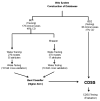Artificial intelligence techniques applied to the development of a decision-support system for diagnosing celiac disease
- PMID: 21917512
- PMCID: PMC3768292
- DOI: 10.1016/j.ijmedinf.2011.08.001
Artificial intelligence techniques applied to the development of a decision-support system for diagnosing celiac disease
Abstract
Background: Celiac disease (CD) is a difficult-to-diagnose condition because of its multiple clinical presentations and symptoms shared with other diseases. Gold-standard diagnostic confirmation of suspected CD is achieved by biopsying the small intestine.
Objective: To develop a clinical decision-support system (CDSS) integrated with an automated classifier to recognize CD cases, by selecting from experimental models developed using intelligence artificial techniques.
Methods: A web-based system was designed for constructing a retrospective database that included 178 clinical cases for training. Tests were run on 270 automated classifiers available in Weka 3.6.1 using five artificial intelligence techniques, namely decision trees, Bayesian inference, k-nearest neighbor algorithm, support vector machines and artificial neural networks. The parameters evaluated were accuracy, sensitivity, specificity and area under the ROC curve (AUC). AUC was used as a criterion for selecting the CDSS algorithm. A testing database was constructed including 38 clinical CD cases for CDSS evaluation. The diagnoses suggested by CDSS were compared with those made by physicians during patient consultations.
Results: The most accurate method during the training phase was the averaged one-dependence estimator (AODE) algorithm (a Bayesian classifier), which showed accuracy 80.0%, sensitivity 0.78, specificity 0.80 and AUC 0.84. This classifier was integrated into the web-based decision-support system. The gold-standard validation of CDSS achieved accuracy of 84.2% and k=0.68 (p<0.0001) with good agreement. The same accuracy was achieved in the comparison between the physician's diagnostic impression and the gold standard k=0. 64 (p<0.0001). There was moderate agreement between the physician's diagnostic impression and CDSS k=0.46 (p=0.0008).
Conclusions: The study results suggest that CDSS could be used to help in diagnosing CD, since the algorithm tested achieved excellent accuracy in differentiating possible positive from negative CD diagnoses. This study may contribute towards developing of a computer-assisted environment to support CD diagnosis.
Copyright © 2011 Elsevier Ireland Ltd. All rights reserved.
Conflict of interest statement
The authors declare that they did not receive any financial support to conduct this research.
Similar articles
-
Machine learning algorithms and forced oscillation measurements applied to the automatic identification of chronic obstructive pulmonary disease.Comput Methods Programs Biomed. 2012 Mar;105(3):183-93. doi: 10.1016/j.cmpb.2011.09.009. Epub 2011 Oct 21. Comput Methods Programs Biomed. 2012. PMID: 22018532
-
Exploring the feasibility of an artificial intelligence based clinical decision support system for cutaneous melanoma detection in primary care - a mixed method study.Scand J Prim Health Care. 2024 Mar;42(1):51-60. doi: 10.1080/02813432.2023.2283190. Epub 2024 Feb 7. Scand J Prim Health Care. 2024. PMID: 37982736 Free PMC article.
-
Medical diagnosis based on artificial intelligence and decision support system in the management of health development.J Eval Clin Pract. 2025 Apr;31(3):e14155. doi: 10.1111/jep.14155. Epub 2024 Oct 21. J Eval Clin Pract. 2025. PMID: 39431542
-
Clinical Decision Support Systems for Triage in the Emergency Department using Intelligent Systems: a Review.Artif Intell Med. 2020 Jan;102:101762. doi: 10.1016/j.artmed.2019.101762. Epub 2019 Nov 17. Artif Intell Med. 2020. PMID: 31980099 Review.
-
Artificial intelligence-based clinical decision support in modern medical physics: Selection, acceptance, commissioning, and quality assurance.Med Phys. 2020 Jun;47(5):e228-e235. doi: 10.1002/mp.13562. Med Phys. 2020. PMID: 32418341 Free PMC article. Review.
Cited by
-
Current Evidence on Computer-Aided Diagnosis of Celiac Disease: Systematic Review.Front Pharmacol. 2020 Apr 16;11:341. doi: 10.3389/fphar.2020.00341. eCollection 2020. Front Pharmacol. 2020. PMID: 32372947 Free PMC article.
-
Interface, information, interaction: a narrative review of design and functional requirements for clinical decision support.J Am Med Inform Assoc. 2018 May 1;25(5):585-592. doi: 10.1093/jamia/ocx118. J Am Med Inform Assoc. 2018. PMID: 29126196 Free PMC article. Review.
-
The Future of Capsule Endoscopy: The Role of Artificial Intelligence and Other Technical Advancements.Clin Endosc. 2020 Jul;53(4):387-394. doi: 10.5946/ce.2020.133. Epub 2020 Jul 16. Clin Endosc. 2020. PMID: 32668529 Free PMC article.
-
Pilot evaluation of sensitive data segmentation technology for privacy.Int J Med Inform. 2020 Jun;138:104121. doi: 10.1016/j.ijmedinf.2020.104121. Epub 2020 Mar 19. Int J Med Inform. 2020. PMID: 32278288 Free PMC article.
-
The utility of including pathology reports in improving the computational identification of patients.J Pathol Inform. 2016 Nov 29;7:46. doi: 10.4103/2153-3539.194838. eCollection 2016. J Pathol Inform. 2016. PMID: 27994938 Free PMC article.
References
-
- Sdepanian VL, Morais MB, Fagundes-Neto U. Celiac disease: evolution in knowledge since its original centennial description up to the present day. Arq Gastroenterol. 1999;36:244–257. (in Portuguese) - PubMed
-
- Hill ID, Dirks MH, Liptak GS, Colletti RB, Fasano A, Guandalini S, et al. North American Society for Pediatric Gastroenterology, Hepatology and Nutrition, Guideline for the diagnosis and treatment of celiac disease in children: recommendations of the North American Society for Pediatric Gastroenterology, Hepatology and Nutrition. J Pediatr Gastroenterol Nutr. 2005;40(1):1–19. - PubMed
-
- Sollid LM. Celiac disease as a model of gastrointestinal inflammation. J Pediatr Gastroenterol Nutr. 2005 Apr;40(Suppl 1):S41–S42. - PubMed
Publication types
MeSH terms
Grants and funding
LinkOut - more resources
Full Text Sources
Medical


